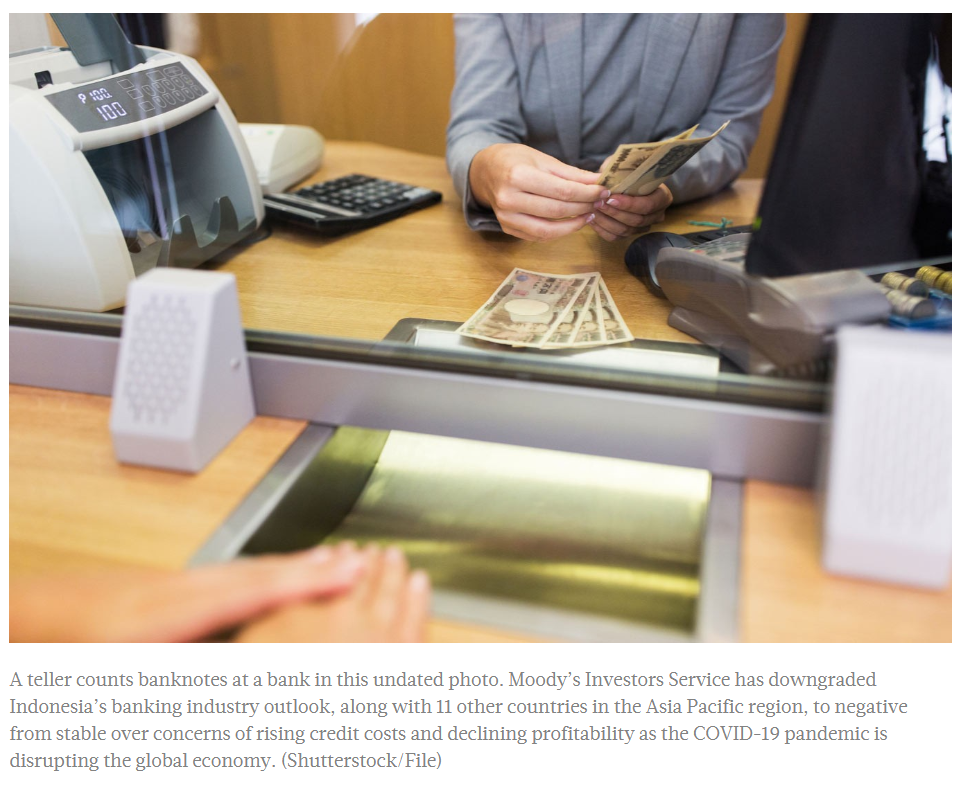COVID-19: Indonesian banks face challenging time but hopes remain
The spread of COVID-19 is expected to hit Indonesian banks’ performance this year, but analysts remain hopeful that the industry will still be resilient enough to face the challenges the pandemic is bringing to the economy.
Moody’s Investors Service has downgraded Indonesia’s banking industry outlook, along with 11 other countries in the Asia Pacific region, to negative from stable over concerns of rising credit costs and declining profitability as the pandemic is disrupting the global economy.
“The coronavirus outbreak has weakened global demand and is increasingly disrupting domestic economic activity,” Moody’s wrote in a report published on April 2.
Its vice president senior credit officer of financial institutions group, Eugene Tarzimanov, further added during a webinar on Tuesday that the disruptions were expected to increase the bad loan ratio in the region, including Indonesia, as they weakened cash flows of small and medium enterprises (SMEs) and corporates in exposed industries, such as airlines, oil and gas and global shipping.
Although Bank Central Asia (BCA) economist David Sumual said on Wednesday that he could not determine how big the rise in the non-performing loan (NPL) ratio would be this year, he admitted that the ratio could increase further if the pandemic continued.
The Financial Services Authority (OJK) recorded gross NPL ratio at 2.79 percent in February, the highest level since May last year. Loan growth, meanwhile, stood at 5.93 percent in the month, reflecting the lowest expansion since November 2009, as demand plunged.
“If the pandemic continues in the next few months, the bad loan ratio could increase because economic activities would be disrupted for a longer period of time,” he told The Jakarta Post.
Such a warning was reflected in the Deposit Insurance Corporation’s (LPS) latest data showing that loan-at-risk stood at 11 percent, chairman Halim Alamsyah said during a hearing with the House of Representatives Commission XI overseeing financial matters. The figure is higher than the 10 percent rate last year.
Private-owned Bank Mayapada Internasional president director Haryanto Tjahjariadi echoed the sentiment, admitting that he expected to see an increase in bad loans as the coronavirus disease hampered economic activities in all sectors.
“However, we will try to maintain our NPL ratio at around the 3 to 3.5 percent this year,” he told the Post.
The rise in bad loan ratio is also expected to increase pressure on banks’ profitability, even on Indonesian banks, which are considered to be some of the most profitable in the world.
“Rising NPL will increase banks’ credit costs while their margins will also decrease due to the central banks’ low interest rates,” Tarzimanov said.
Bank Indonesia (BI) in March cut yet another 25 basis points off of the benchmark seven-day reverse repo rate to 4.5 percent. It also lowered the deposit facility rate to 3.75 percent and lending facility rate to 5.25 percent.
The lower rates are expected to transmit into lower banks’ interest rates, affecting consumer loans, corporate loans and mortgage interest rates. This will then translate to lower net interest margin (NIM), which usually determine a bank’s profitability.
Senior economist Aviliani said on Friday that banks’ NIM had already decreased in the past few years due to tight competition since the digital era.
Data from the Financial Services Authority (OJK) showed that banks’ NIM ratio stood at 4.91 percent in 2019, lower than the 2016 figure of 5.63 percent.
Given that the OJK has allowed more relaxed restructuring among debtors amid the pandemic, Aviliani said she expected banks’ NIM would further decrease.
Last month, the OJK issued a new regulation that relaxed debt quality assessment and restructuring requirements for debtors that are hit hard by the coronavirus pandemic, allowing them to assess the quality of a loan worth up to Rp 10 billion (US$637,795) based on only the debtor’s timeliness in paying the loan’s principal and interest.
“I think the NIM will significantly decline from April to June as the COVID-19 pandemic continues,” she said during an online discussion.
Despite the bleak outlook, she still expressed optimism that some banks could still record profits amid the less-than-favorable conditions.
“Banks that don’t rely heavily on interest income as their main revenue stream and have strong fee-based income can still book a profit despite today’s conditions,” she said.
Although Moody’s expects bank profitability to decrease as they needed to increase their provision, Moody’s vice president senior credit officer Alka Anbarasu also said Indonesian banks could still survive during the challenging climate as she believed they could absorb the increase in credit costs while still supporting internal capital generation.
David of BCA echoed the sentiment, saying that Indonesian banks were among the strongest in the emerging market due to the high capital adequacy ratio (CAR) percentages.
“Our banks’ CAR currently sits around the 23 percent level. The rise in NPL and credit costs may cause the banks’ CAR to decline, but overall it is still stronger than most other banks in the emerging market,” he said.
Source: https://www.thejakartapost.com/news/2020/04/13/covid-19-indonesian-banks-face-challenging-time-but-hopes-remain.html


 Thailand
Thailand




